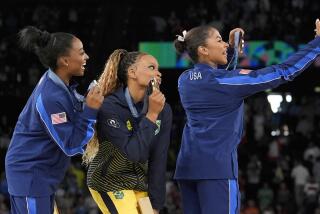Women Try to Bridge the Gap in Championship Play
At a makeshift bookstore set up for the North American Bridge championships, somewhere between “Clobber Their Artificial Club” and “The Weak Two Bid in Bridge” was a small red book titled “Why Women Lose at Bridge.”
It may be an understatement to call the issue controversial.
“On the average level, women are better,” said Dorothy Truscott, 62, of New York, the only living woman to have made it to the Bermuda Bowl, an open competition for the world championship. The other was Helen Sobel, the partner of bridge ace Charles Goren.
“Women are more reasonable, read books and take lessons. Until recently, women had more time,” she said. Sixty percent of the American Contract Bridge League members are women, but of the top 1,000 bridge players, just half are women, and of the best 100, just five are women, officials estimated.
Top players are usually aggressive, competitive, have the ability to concentrate, have courage, confidence, good judgment and a good partner.
A major problem, according to men and women champions, is that young girls are not trained to be as aggressive and competitive in the warlike atmosphere of big-time duplicate bridge. “For every woman properly indoctrinated, we’ve got 100 men,” world champion Bob Hamman said.
Also, all the top experts began playing bridge full time when they were young, he said. “If you’re not pretty good by age 22, forget about it. You’ve got to learn the (mental) reflexes.”
Many of the top men players dropped out of school to play bridge full time. “It’s less reprehensible for men to drop out and become card bums,” he said.
Women cannot easily improve their game by playing with better players because of some sex-segregated events at tournaments, said Jan Martel, second vice president of the American Contract Bridge League’s Forum for Women in Bridge.
An anonymous flyer that appeared at the tournament Thursday complained that officials had scheduled segregated events on four of the tournament’s 10 days. “These gender restrictions are arbitrary, capricious and bad business,” it said.
Several years ago, two players, Jill Blanchard of New York and Jean Popo of the San Francisco peninsula, sued the A league when officials denied their application to enter a men-only event. The suit is pending, but an injunction allowing them to play in the Anaheim nationals was denied, Martel said.
The forum supports the system used by the World Bridge Federation in international events that hold women’s events and open events but no men’s events. “We have not taken a position on men’s events,” she said.
“Some women feel men are less pleasant to play against, and therefore they enjoy events limited to women.”
In one sense, women have an advantage in international competition by being able to enter women’s teams, women’s pairs or open teams. But because women’s and open qualifying events are scheduled at the same time, women who want to win usually choose the women’s events, she said.
Kathy Wei, who this year has won her third gold medal on all-women’s teams in the World Bridge Olympics, said: “They say talk is cheap, (but) we haven’t won an open title. I think we should start to try.”
But most women haven’t had the chance to get out of the kitchen and get “reprogrammed,” said Wei, who with other women players established day care at national bridge events.
In her case, she said, she benefited from her late husband, shipping magnate C.C. Wei, who encouraged her to resign from medicine and pursue bridge full time. She studied in Rome with Italian experts, then world champions.
“You have to be totally committed (in terms of) money, time and training to be a champion,” Wei said.
More to Read
Go beyond the scoreboard
Get the latest on L.A.'s teams in the daily Sports Report newsletter.
You may occasionally receive promotional content from the Los Angeles Times.










